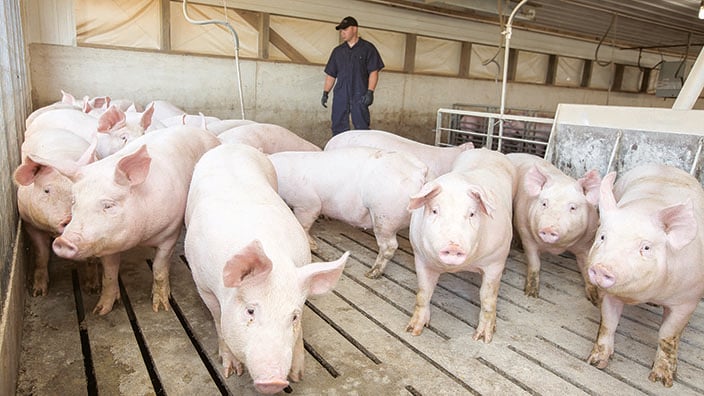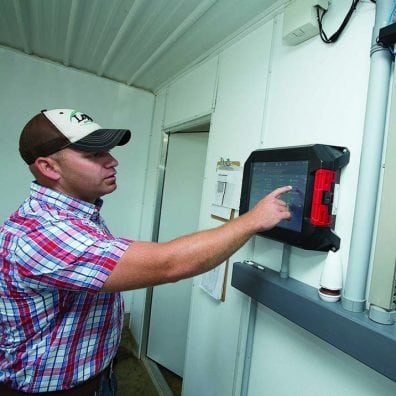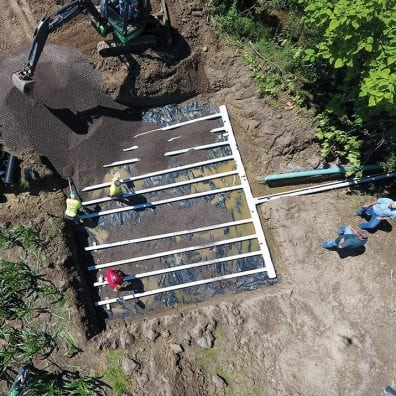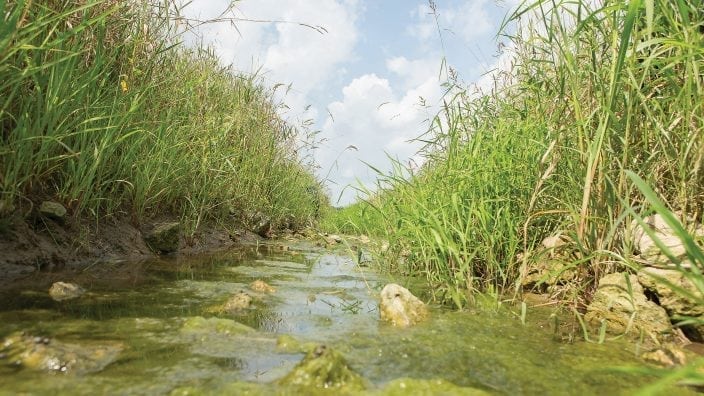Applications for Ohio Farm Bureau Health Plans now available
Members have three ways to apply: contacting a certified agent, calling 833-468-4280 or visiting ohiofarmbureauhealthplans.org.
Read MoreAfter heavy rain events fell on northwest Ohio throughout the spring and early summer, it wasn’t surprising that a significant algal bloom would surface on the Western Lake Erie Basin.
When it did, Henry County Farm Bureau member and farmer Dusty Sonnenberg knew the “war would be back on.”
“That’s what it feels like — a war,” Sonnenberg said. “It doesn’t matter what farmers are doing or what practices they have implemented, they will be judged as guilty.”
Sonnenberg noted that when the lake turns green everyone — the public, politicians, the media — are “quick to point fingers and lay blame.”

As outside pressure to “do something” grows, some feel the need to place more heavy restrictions on farmers. That leaves many farmers frustrated that the efforts they have already put forth aren’t being given the time needed to materialize into significant enough solutions to make a difference.
Patience and frustration often go hand in hand, and nowhere is that clearer than in the fight to free the Western Lake Erie Basin of annual algal blooms.
Activists and some in the public are frustrated because the problem isn’t solved right now. They’ve run out of patience. Farmers are frustrated because they are trying to help solve the problem, but they know it is going to take a lot of patience to do so.
Plus, there are still questions that need to be answered, Sonnenberg said. One complex question revolves around exactly how the nutrients that escape farm fields make their way into Lake Erie’s tributary streams and creeks and then eventually into the lake itself. It is still a matter of intense scientific study.
“We’re still trying to figure out how it moves (through specific fields),” Sonnenberg said, “and what the best practices are (to prevent runoff).”
Sonnenberg, who runs a small cash grain farm as well as freezer beef operation and raises dairy replacement heifers, noted that farmers are not trying to deny there is a problem. They aren’t trying to deny nutrient runoff is a major contributor to the problem. The reality is 180 degrees in the opposite direction.
“Every farmer I know is trying to do the right thing,” Sonnenberg said. “Honestly, I’ve been very impressed with the number of farmers who have best management practices already in place — cover crops, controlled drainage structures, nutrient management plans.”
Hancock County Farm Bureau board member Evan Jackson is trying to do just that — the right thing.

Jackson, a Findlay native, is the seventh generation making a living on the family farm, working land in both Hancock and Putnam counties. Jackson started farming full-time with his father in 2011 after serving in the military.
Water quality and agriculture’s role in it is top-of-mind in his corner of the state. He said he’s always worked to do what he can to make sure the nutrient runoff on his family farm is as minimal as possible.
“We use cover crops,” he said. “Our hog barn is new and the nutrient management plan is being finalized now. We have water control structures around the hog barn. With our cattle we use best practices.”

Jackson, with a family farm that consists of 200 head of cattle, the hog finishing facility, 150 bee hives and 1,000 acres of crops, said he is planning to implement more conservation practices as he’s able.
“I’m 30 years old, at the beginning of my career,” he said. “There are issues going on that are just going to get more prevalent as time goes by. It’s foolish to think we can keep doing what we’ve always done and get different results.”
Jackson is trying to do what he can, with the resources he can provide on an operation that supports an entire family, to put conservation practices in place that will help ensure the goals of better water ultimately headed into Lake Erie. It’s not easy, simple or inexpensive.

“I can’t afford to go out and spend tons of money,” he said. “I have to stay the course, implement the (conservation) practices when I can and give them time to work.”
What works and what might need modified is something Bill and Shane Kellogg have been investigating at their Hardin County farm in Forest the last couple of years.
The Kellogg family farm is part of the Blanchard River Demonstration Farms Network, a $1 million partnership between Ohio Farm Bureau and the U.S. Department of Agriculture Natural Resources Conservation Service. The partnership was created to demonstrate on-farm conservation practices to help improve water and nutrient conservation.
The farm consists of 5,000 acres of corn and soybeans and of those, 305 acres are committed to the network. Subsurface nutrient placement — deep incorporation of fertilizer placed right where the future crop needs it rather than wide application — is one of several conservation practices on the farm, including the use of cover crops.
“The cover crops require a lot more management and they can be a challenge,” he said. “We’re still playing around with them (to see what works best on our land).”
The use of subsurface placement has been a success, he said. “It’s more efficient and we’re doing something good for the environment.”

Both Kellogg and Jackson get frustrated by what Jackson calls “knee-jerk reactions” from both the general public and elected officials and the inability often for voices like theirs to be heard.
“I get very frustrated with some of the misinformation that is out there,” Kellogg said. “You hear it from people who don’t know about agriculture.”
Jackson agreed and said those voices tend to drown out the people who do work in the industry every day.
“There aren’t as many farms as there used to be,” he said. “We don’t have as big a voice to defend our point of view.” He added that Ohio Sen. Rob McColley recently visited his farm and Jackson explained his frustration to him.
“I told him we need an advocate,” he said. “We don’t need knee-jerk reactions that we don’t know how it will affect us in the long run.”
To that end, Sonnenberg said he doesn’t see how additional state or federal regulations are going to make a great deal of difference.
“Farmers are already heavily regulated,” he said. “I don’t know what else they can require. Other than creating headaches and scoring political points, from a boots-on-the-ground standpoint, I don’t see what (more regulations) looks like.”
An executive order signed by Gov. John Kasich in July put farmers in the Lake Erie watershed back in the spotlight.
The executive order aimed to name eight Lake Erie watersheds as “watersheds in distress” and would have affected 2 million acres of farmland and 7,000 farmers, all without input from farmers, lawmakers or other interested parties.
The Ohio Soil and Water Conservation Commission ultimately decided the decision to designate the watersheds in distress needed further study. This is what was being asked for by Farm Bureau and the Ohio General Assembly, which just passed Clean Lake 2020, legislation that addressed many of these issues and put money behind them.
“Ohio Farm Bureau is ready to work with the commission, legislators, environmental organizations, our fellow farm groups, the scientific community and the Kasich administration to find effective solutions to Lake Erie’s challenges,” said Adam Sharp, executive vice president of the Ohio Farm Bureau Federation.
Farmers know there is a problem and have already made progress on reducing nutrient losses off their fields under existing regulations and voluntary efforts.
Information
Visit farmersforwater.org for more information.


Members have three ways to apply: contacting a certified agent, calling 833-468-4280 or visiting ohiofarmbureauhealthplans.org.
Read More

Bill Patterson, Cy Prettyman and Adele Flynn will continue to serve as officers for Ohio Farm Bureau Federation.
Read More

Delegates discussed many topics impacting agriculture including farmland preservation, local foods, and succession planning.
Read More

Twenty-six farmers govern the state’s largest farm and food organization.
Read More

The 2025 recipients are Fred Cooke (posthumous) of Richland County, Marvin Dietsch of Williams County, Steven Knollman of Hamilton County and Michele Miller (posthumous) of Ottawa County.
Read More

Nathan and Jill Parriman grow seasonal crops, including Christmas trees, pumpkins and cut flowers, providing U-cut experiences that invite customers to engage directly with agriculture.
Read More

The 2025 Distinguished Service Award recipients are Craig Adams, Mike Townsley, and Kellogg Farms, Kurt Farms and Stateler Family Farms.
Read More

Ohio Farm Bureau Treasurer Adele Flynn participated in the meeting, representing Ohio farmers.
Read More

For Ohio and PJM region, the outlook is reassuring—ample reserves and strong planning should keep the power on.
Read More

The average price for a classic holiday feast for 10 in Ohio will cost $55.87.
Read More